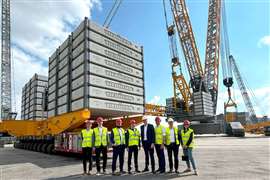Big infrastructure builds across the United States
14 September 2023
Infrastructure covers a range of projects, but for the most part involves physical systems that help the greater good. More often than not, infrastructure projects comprise work that is behind the scenes, although the construction or reconstruction can cause disruptions in traffic and other public services. The work is often performed at night to maximize safety and minimize public inconvenience. Following is a sampling of infrastructure projects under way or recently completed around the country.
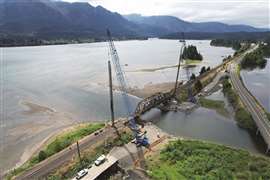 Two 4100 Ringers install a girder bridge.
Two 4100 Ringers install a girder bridge.
Advanced American Construction (AAC) recently completed the assembly and installation of a 208-foot-long deck plate girder bridge for BNSF Railway near Stevenson, WA. AAC used a 4100 Ringer Crane to assemble and fly four girder sections across Rock Creek. Each girder section was 12 feet tall and weighed approximately 310,000 pounds.
In June, AAC hired Lampson International to erect a second 4100 Ringer Crane o site in preparation for the full bridge changeout. AAC was granted a 31-hour BNSF rail shutdown while the pick was made. The Ringer Cranes were used to lift the 100-plus-year-old railroad bridge off its foundation and set it onto a floating barge in Rock Creek. The existing railroad bridge was 150 feet long and weighed approximately 420,000 pounds. AAC then used the cranes to demolish pre-cut concrete pier sections, each weighing 150,000 pounds. Before the bridge changeout, AAC had to slide the new railroad bridge approximately five feet to the south to open up clearance for the cranes’ counterweights. This move allowed the cranes to swing 360 degrees and perform the two-crane pick of the existing railroad bridge.
Both cranes had to be erected under extremely tight site conditions, due to permit requirements, limiting the amount of fill in Rock Creek. Due to the small pad size of 50 by 55 feet, the cranes were erected on Lampson’s mud boats for additional stability.
Roadway elevation
Over the past several years, the state of Washington has worked to improve fish passageways under roadways throughout the state. When a high-traffic thoroughfare in Kent, WA came up for necessary elevation, Omega Morgan’s Seattle crane services team was contracted to provide essential heavy lift and placement services for girders along the roadway in two phases.
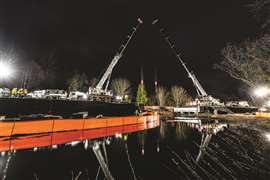 Omega Morgan installed nine bridge girders.
Omega Morgan installed nine bridge girders.
Omega Morgan’s crane services team got to work as soon as they received the project. Their objective was to raise the roadway by several feet, and because of heavy traffic, each side of the road would be elevated individually. Omega Morgan developed several possible plans to execute the heavy lifts and made multiple site visits over the course of about three months as the construction team built up one side first. The initial plans included one crane, but the engineering team confirmed that one crane would put too much pressure on the elevation system. Staying flexible, Omega Morgan changed course and engineered a two-crane solution utilizing their 180-ton and 120-ton Tadano cranes. This reduced the ground pressure and redistributed the weight to a safe and effective level.
On the scheduled day, a crew of nine including a maintenance superintendent, two crane operators, two oilers and four drivers, arrived with the cranes at 9 p.m. to set up. The traffic has been compressed into one alternating lane, and three trucks made round trips carrying the nine 62-feet-long, 63,200-pound girders to the jobsite individually.
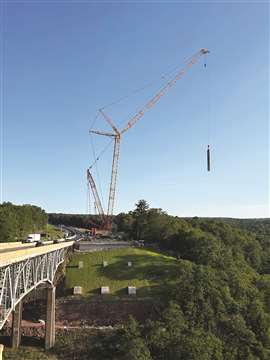 Buckner HeavyLift supplied two crawlers for the Hawks Fallls Bridge replacement.
Buckner HeavyLift supplied two crawlers for the Hawks Fallls Bridge replacement.
Buckner HeavyLift has two Liebherr LR11000s working on the Hawks Falls Bridge replacement project in Pennsylvania. The overall length of the steel arch bridge is 720 feet, with a main 480-foot deck arch span and two 60-foot I-girder spans on each end. The new steel structure will stretch over the 700-foot-deep ravine, and will carry the Turnpike’s Northeast Extension (I-496) over Mud Run in Carbon County, PA. The project includes a single-span steel girder bridge crossing Hickory Run Road.
What makes this job difficult is that the south side is lower than the north side. The two LR11000s will be working simultaneously to complete the installation, and once the middle piece is set and the lowering of the bridge into position, there is about a quarter of an inch room for error. Even the ambient temperature has to be a specific degree in order to keep the plate from expanding and contracting.
Both of Buckner’s LR11000s are in a SDWB2 configuration with 217 feet main boom, 295 feet with luffing jib, 463K super structure, 110.2K car body and 992.1K tray. The maximum weight of the lift for this job is 90,000 pounds at 410 feet radius for both sides.
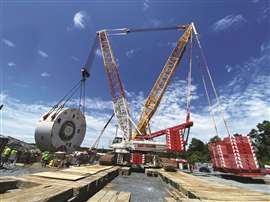 Bay Crane lifts a tunnel boring machine that is digging a tunnel in Rhode Island.
Bay Crane lifts a tunnel boring machine that is digging a tunnel in Rhode Island.
Bay Crane lifted and installed a tunnel boring machine (TBM) that is amid tunneling operations on the RestoredWaters RI project in Rhode Island. This is the third phase of the project that involves building a 2.2-mile-tunnel 125 feet underground that will collect and transport storm-related sewage overflows to the Seekonk River so that water can be treated at NBC’s Bucklin Point wastewater treatment facility.
Tunneling operations have begun. The TBM began its journey at the School Street site and moving north through the cities of Pawtucket and Central Falls.
While the TBM will be largely undetectable at the surface as it progresses along the tunnel route, there is material removal activity at the surface at the School Street site. As the material comes out of the tunnel, it travels along a conveyer system where it is loaded into dump trucks and transported off site.
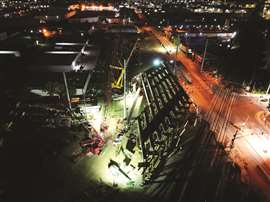 A Maxim AT and crawler work on an overpass in Santa Fe Springs, CA.
A Maxim AT and crawler work on an overpass in Santa Fe Springs, CA.
Maxim Crane Works assisted in a project for the Los Angeles County Metropolitan Transportation Authority to build an overpass over a dangerous railroad crossing at the intersection of Rosecrans and Marquardt Avenues in Santa Fe Springs, CA.
The California Public Utilities Commission (CPUC) rated the intersection as the “most hazardous” railroad crossing in the state due to past collision history, the volume and speed of vehicular traffic and frequency of trains that use the tracks. An estimated 45,000 vehicles and 130 trains daily use the intersection of Rosecrans and Marquardt. Trains cross about every 10 minutes bringing vehicle traffic to a standstill for 21 hours per week, according to LA Metro. The $137 million project included building an overpass to route car and truck traffic above the country’s second-busiest passenger rail corridor. Maxim provided a Manitowoc MLC300 VPCMAX crawler and a Liebherr LTM1400 7.1 all-terrain crane for the project.
Louisiana Highway 1
Bigge Crane & Rigging won the contract to supply five Kobelco CK2750 crawler cranes to work on the Louisiana LA 1 Highway, a five-year project to build a new access point in the form of an elevated roadway to one of the only offshore supply ports on the Gulf Coast.
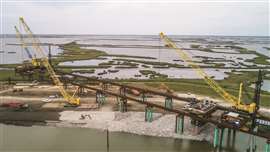 Bigge supplied five Kobelcos for the LA 1 project.
Bigge supplied five Kobelcos for the LA 1 project.
The highway and the replacement bridge are a lifeline to the Louisiana coast. This area of sensitive wetlands has been the victim of coastal erosion and ground subsidence, and the existing highway is literally sinking. Each year, tropical storms pose more of a threat to LA 1, which now often floods in low-level storms and strands coastal residents, tourists and the oil industry workers who use Port Fourchon as a primary access to Gulf operations. When complete the LA 1 Bridge will be almost as long as the nearby Pontchartrain Bridge in New Orleans, generally regarded as the world’s longest bridge.
After thoughtful negotiation, Bigge put together a plan to include bare rental of the cranes and a maintenance plan specifically tailored to the customer. The first cranes were delivered in the spring of 2022.
An upcoming second phase of the project will start on the southern end and work north, where Bigge’s cranes have been hoisting steel, concrete and other road building materials. The next phase will require at least three more 275-ton crawlers.
STAY CONNECTED


Receive the information you need when you need it through our world-leading magazines, newsletters and daily briefings.
CONNECT WITH THE TEAM










